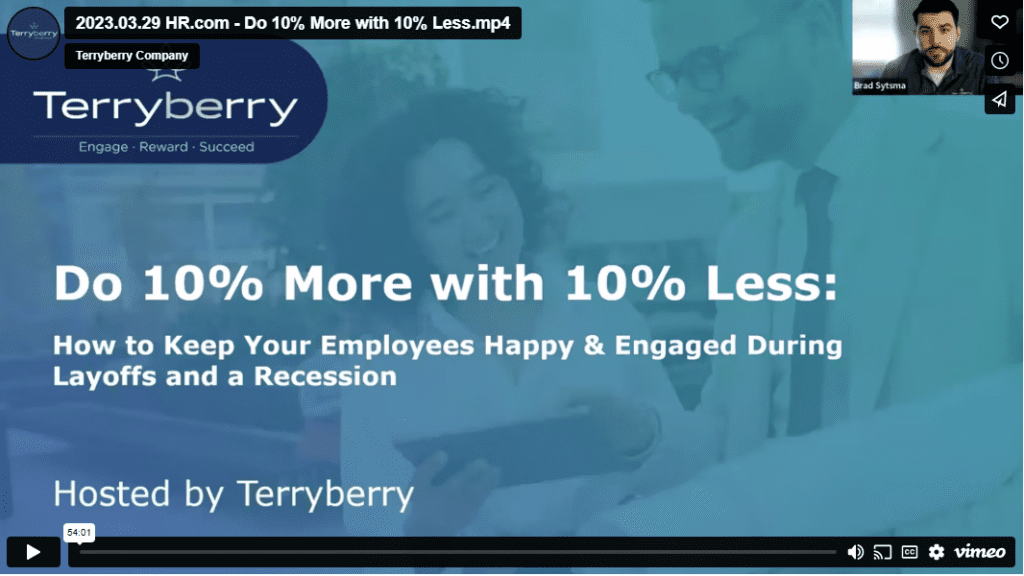March 30, 2023

Recession or no recession? That is the question.
Since mid-2022, economists and laymen alike have debated over whether to expect a recession in 2023. Some say we’ve technically been in one since the summer of 2022, based on the definition of “recession.” Others say corporate earnings are too high to be considered a recession, and with how rare they actually are, a recession is unlikely.
While that debate continues, one thing we know regardless is that layoffs have already begun. And many employees are uneasy.
Worried employees are not only a drain on morale, they can also lead to a distracted, disengaged, and inefficient work environment. To help combat this, we discuss how to keep your workforce happy, engaged, and feeling appreciated during uncertain economic times.
Our Current Environment
While the current employment market is strong – low unemployment and high job growth – this may be changing as businesses respond to an adjusting economy.
At the end of 2022 and into the beginning of 2023, we had already begun to see some notable layoffs – from Amazon to Google to Facebook. And while it’s true that big tech may have overshot their hiring during the pandemic when lockdown sparked a tech buying surge, it’s not just tech that’s making cuts.
It seems companies everywhere have made slashes. This inevitably leaves employees feeling insecure and contemplating their next move.
In fact, employee engagement and mental well-being have been on a steady decline. In March of 2022, the WHO reported a 25% worldwide increase in anxiety and depression and 52% of workers reported feeling burned out.
Additionally, a recent Gallup report found that 68% of workers are currently either disengaged or actively disengaged in their work. And any HR worker or leader will agree – lack of engagement is bad for business.
Employee disengagement leads to higher turnover rates, increased costs, decreased productivity, and lower morale for the remaining employees. It can also have a negative impact on overall customer satisfaction.
So, what can leaders do about this? Watch the webinar on this topic here.
How to Boost Morale and Engagement During Difficult Times
In uncertain times, like during layoffs and a potential recession, it’s crucial for managers and leaders to prioritize their employees’ wellbeing. This means actively investing energy into all facets of the employee experience, from recognition to wellness to career development.
Here’s where to start:
Nurture Your High-Potential Employees
High-potential employees are employees who have the potential to succeed beyond their current role. If your company is planning layoffs (and even if you’re not) identifying these employees can be critical.
This is because of Pareto’s principle, or the “80/20” rule. Research has found that roughly 80% of organizational output is done by the top performing 20% of employees. So, ensuring you nurture the right employees can have a significant impact on productivity.
Unfortunately, during layoffs, managers will oftentimes “quiet promote” their high-potential employees. That is, give employees duties and responsibilities beyond their current role without a formal promotion or pay raise.
While this is understandable to a degree - like asking employees to temporarily take on slightly more work to bridge short-term gaps in responsibilities. When handled poorly, it can lead to burnout and resentment.

What to do:
Invest back in these high-potential employees. This means, first, being transparent about layoffs that have happened. Acknowledge the disruption and how it's probably leading to anxiety and insecurity amongst the team. Also, reassure them that their roles are safe, their skills are valued, and you see a future for them with your company.
On that same note, consider offering these employees training programs, courses, and opportunities to develop their skill sets further. This helps reinforce that you plan on keeping them with the company for the long term.
Next, be upfront about any extra work you’re asking your existing employees to take on and how long they'll be expected to do so. Lastly, be proactive about bonuses, pay raises, and promotions. If you can’t compensate your employees for longer-term extra work, you probably shouldn’t be asking them to do it.
RELATED: High-Potential Employees: 5 Ways to Identify & Develop Your Most Valuable Employees
Celebrate Small Wins
It’s always important to recognize a job well done, but it’s especially important during difficult times. Employees need to feel psychologically safe at work, and being recognized helps achieve that. This is because recognition releases feel-good neurochemicals, like dopamine and oxytocin.
When an employee’s hard work is acknowledged and appreciated, it triggers a dopamine and oxytocin release in the brain. Dopamine is powerful, motivating, and reinforces the behavior.
One study even found that receiving a compliment, like genuine recognition, is just as thrilling to the brain as receiving cash — both are perceived by the brain as "social rewards."
Oxytocin, on the other hand, helps reduce cortisol – the stress hormone. But both dopamine and oxytocin’s positive effects wear off quickly. This means that while recognition is powerful, it needs to also be frequent to be most impactful.
The benefits of recognition don’t stop with the employee either, it’s good for business too. Research has found that when employees believe they’ll be recognized for their work, they’re 2.7 times more likely to be highly engaged.
82% of people are happier when they’re recognized at work, and the single most important driver for employees to do “great work” is employee recognition.
What to do:
Recognition can be as simple as a verbal acknowledgement in a team meeting or a passing comment in the hall. But in order to be effective, recognition needs to be genuine, frequent, and it needs to emphasize how the actions play a role in the greater mission of the company.
Building a culture of recognition will take some time, effort, and strategic planning. To help move this along, encourage managers, in particular, to lead recognition efforts.
While peer recognition is important, many employees place a greater significance on positive feedback from a superior. So, work with managers to set some clear goals and guidelines around your recognition plan.
If you'd like help getting started with a recognition strategy, see how Terryberry can help.
Prioritize Wellness
In a 2021 survey by the APA, 79% of respondents had experienced work-related stress in the previous month and 32% reported emotional exhaustion. 32% of employees have taken a sick day due to stress. And while mental health is a vital component of a person’s overall wellbeing, barely half (51%) of employees believe that their workplace supports mental health.
All this to say, employees were struggling before a looming recession, so if you haven't been prioritizing wellness, now is a good time to start. Wellness initiatives are a great way to not only improve employee wellbeing, but company culture as well.
Wellness programs help establish a sense of belonging and togetherness, which can improve engagement and lead to higher productivity. Furthermore, at companies that support wellbeing initiatives, 89% of employees are more likely to recommend the business as a good place to work.
What to do:
For many people, the phrase “corporate wellness” sparks ideas of step challenges or healthy diets, but wellness doesn’t need to be limited to physical wellness. During difficult times, instead try focusing on employees’ mental wellbeing.
If your company has a wellness program in place, use this to facilitate mental wellness challenges. These can range from meditation and gratitude challenges to volunteering and community involvement opportunities.
Also, consider offering other low- or no-cost wellness incentives. These can include offering mental health days as part of your sick days or PTO policy, partnerships with apps or gyms, or giving recognition points on an employee recognition platform.
RELATED: A Step-By-Step Guide to Developing Employee Wellness Programs
Getting Started
Living in tumultuous times calls for leaders to rethink their retention strategies. Without making conscious efforts to adapt to changing times, companies are risking their employees burning out, disengaging, or leaving. But leaders who are looking to nurture their employees can not only survive layoffs and a recession, but even achieve more with less.
Interested in learning more about how your company can benefit from employee recognition software? Schedule a demo of Terryberry's 360 Recognition Platform today.

